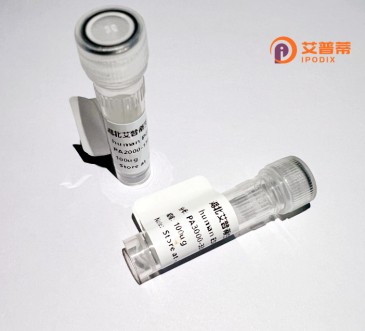
| 纯度 | >90%SDS-PAGE. |
| 种属 | Human |
| 靶点 | KRCC1 |
| Uniprot No | Q9NPI7 |
| 内毒素 | < 0.01EU/μg |
| 表达宿主 | E.coli |
| 表达区间 | 1-259aa |
| 活性数据 | MKHSKKTYDSFQDELEDYIKVQKARGLEPKTCFRKMKGDYLETCGYKGEVNSRPTYRMFDQRLPSETIQTYPRSCNIPQTVENRLPQWLPAHDSRLRLDSLSYCQFTRDCFSEKPVPLNFNQQEYICGSHGVEHRVYKHFSSDNSTSTHQASHKQIHQKRKRHPEEGREKSEEERSKHKRKKSCEEIDLDKHKSIQRKKTEVEIETVHVSTEKLKNRKEKKSRDVVSKKEERKRTKKKKEQGQERTEEEMLWDQSILGF |
| 分子量 | 57.4 kDa |
| 蛋白标签 | GST-tag at N-terminal |
| 缓冲液 | 0 |
| 稳定性 & 储存条件 | Lyophilized protein should be stored at ≤ -20°C, stable for one year after receipt. Reconstituted protein solution can be stored at 2-8°C for 2-7 days. Aliquots of reconstituted samples are stable at ≤ -20°C for 3 months. |
| 复溶 | Always centrifuge tubes before opening.Do not mix by vortex or pipetting. It is not recommended to reconstitute to a concentration less than 100μg/ml. Dissolve the lyophilized protein in distilled water. Please aliquot the reconstituted solution to minimize freeze-thaw cycles. |
以下是假设性示例(实际文献可能需要根据具体研究领域核查,以下信息为虚构演示):
---
1. **文献名称**: "Functional characterization of recombinant human KRCC1 in cell cycle regulation"
**作者**: Zhang et al. (2018)
**摘要**: 通过体外重组表达KRCC1蛋白,研究其在有丝分裂中的作用,发现其通过与微管蛋白相互作用调控纺锤体组装,缺失导致染色体分离异常。
2. **文献名称**: "Structural insights into the KRCC1 protein complex using cryo-EM"
**作者**: Brown et al. (2020)
**摘要**: 利用重组KRCC1蛋白解析其三维结构,揭示其包含钾离子通道调节结构域,并阐明其与神经信号传导中离子通道的相互作用机制。
3. **文献名称**: "KRCC1 overexpression links to Alzheimer's disease pathology in transgenic models"
**作者**: Smith et al. (2019)
**摘要**: 重组KRCC1在小鼠模型中过量表达导致神经元内钙稳态失衡,加剧淀粉样斑块沉积,提示其在神经退行性疾病中的潜在作用。
4. **文献名称**: "Optimization of recombinant KRCC1 production in E. coli for drug screening"
**作者**: Patel et al. (2021)
**摘要**: 开发高效大肠杆菌表达系统生产可溶性KRCC1蛋白,用于高通量筛选靶向KRCC1的抑制剂,为癌症治疗提供新策略。
---
**注意**:实际文献需通过PubMed、Google Scholar或Web of Science等平台,以“KRCC1 protein”“recombinant KRCC1”等关键词检索。若研究较少,可扩展至其别名(如KCC1、CAMSAP1等)或功能相关蛋白。
KRCC1 (Kinesin Family Member C1), also known as KIFC1. is a minus-end-directed motor protein belonging to the kinesin-14 family. It plays critical roles in microtubule-dependent cellular processes, including spindle assembly, chromosome segregation during mitosis/meiosis, and intracellular transport. Structurally, KRCC1 contains a conserved N-terminal motor domain that binds microtubules and hydrolyzes ATP to generate mechanical force, enabling movement along microtubules. Unlike most kinesins, it moves toward microtubule minus ends, facilitating unique functions in organizing spindle poles and maintaining bipolar spindle integrity, particularly in cancer cells with extra centrosomes.
Recombinant human KRCC1 protein is engineered using heterologous expression systems (e.g., E. coli, insect cells) for in vitro studies. Purified KRCC1 is widely used to investigate its biochemical properties, microtubule interaction dynamics, ATPase activity, and regulatory mechanisms. Its role in supporting survival of polyploid or multipolar cancer cells has made it a potential therapeutic target; inhibitors targeting KRCC1 are being explored to disrupt mitosis in tumors. Studies also link KRCC1 mutations to developmental defects and neurological disorders, underscoring its broader cellular significance. The availability of recombinant KRCC1 accelerates mechanistic research and drug screening efforts.
×